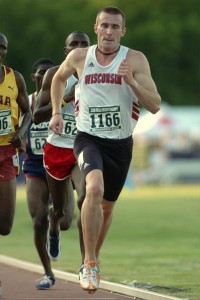Earlier this year, Chris Solinsky stunned the nation as he shattered the American Record in the 10,000 meters. Running 26:59 in his debut 10k, Solinsky became the first ever American under 27 minutes and the fastest ever non-African. A month later, Solinsky ran 12:56 for 5,000 meters – the 4th American under 13 minutes.
What’s his training secret?
Well, hard work. Solinsky has been diligently training and putting in high-mileage weeks for years, increasing his intensity, and focusing on high-end aerobic development. Year after year, his training has been consistently high-volume with quality workouts.

While many factors have contributed to Solinsky’s consistency including core workouts and maximizing recovery time, one aspect of his training that is evident when I watch him race is his incredible efficiency. Chris Solinsky runs with almost textbook form which has helped him stay healthy and fast.
Five Tips to Improve Your Mechanics
1) Keep your back tall. Remember when your mom told you to stop slouching? She was right. It wasn’t right when you were a kid and it’s not helping you today. Slouching puts a lot of stress on your legs as you shift your body weight forward. Avoid this stress and the breaking motion you’re forcing your body to do by keeping your back tall.
Pretend a string is pulling you up from the top of your head. You can lean slightly forward – but don’t lean from the waist. Lean from your ankles – your entire body should be leaning forward instead of just at the waist.
2) Midfoot or Heel strike? I used to think that if you’re landing on your heels then your body is experiencing a braking motion mid-stride. Braking during a run obviously slows you down, but it also amplifies impact forces from landing. But it depends on the type of heel strike you have (and trying to change your form can reduce your efficiency).
In an ideal world you would land flat footed with your leg ready to spring up into the next phase of the running cycle. This style of running, often touted as something “new” by POSE or Chi running fans (when in fact it’s just the correct way to run), will reduce impact shocks and make you faster.
This is illustrated clearly in the Running Form Course.
3) Where you land on your foot is important, but equally important is where on the ground your foot lands. Your foot should make contact with the ground underneath your body. You will likely land just in front of your center of mass but that’s ok – the point is to not over-stride. Many new runners try to over-stride and “reach” forward with their legs, causing them to land significantly ahead of their center of mass.
Keep your legs underneath your body when you’re landing and you will drastically reduce those impact forces and improve efficiency.
4) Perhaps the most important way to land on your mid-foot underneath your body is to have a quick cadence. Your running cadence is your stride-rate – or the number of steps you take per minute.
According to legendary coach Jack Daniels (and many others), the cadence to shoot for is 180 steps per minute. That’s a good goal, but keep in mind it’s not a magic number. You can be a bit less or more than 180 steps per minute. They key is to increase your cadence by about 5-10% if it’s less than 160. Quick strides place less stress on your legs because the muscular contractions don’t have to be as forceful.
5) To put it all together, a mental trick I use is to always remind myself to run quickly but softly. With a high stride-rate, I try to run as quietly as possible almost like I’m a ninja. I’ve run up on some dogs and scared them, so I know I must be doing a good job. If you’re landing softly, you’re not slamming your legs into the ground.
Putting it All Together – What Next?
Proper running form is probably the most overlooked aspect of the sport. Beginner runners sign up for cookie-cutter training plans that have tempos, long runs, and interval workouts but there’s no mention of the right way to run. Would we teach swimming without first teaching the basics of the freestyle stroke?
Visit any running message board and you’ll find hundreds of threads about shin splints, achilles injuries, and any other running ailment you can think of. The problem is that new runners think that anybody can run. Well, sure. But not everyone runs well and sometimes it takes a step-by-step approach.
A recent study showed that in trained runners, stride variation was much lower than non-runners. This seemingly simple study shows that running at a higher level is a skill. Just as your aerobic capacity and speed need to be continuously worked on, your running form should be constantly improved upon also.
The great part about implementing these running form techniques is that every one is achievable. Unlike other biomechanical inefficiencies, like over-pronation or low arches which are difficult to fix (I know, I have both), most aspects of good running form can be learned.
Need help? Check out the details of the Running Form Course.
Recommended Reading:
- Dr. Nicholas Romanov’s Pose Method of Running
- ChiRunning: A Revolutionary Approach to Effortless, Injury-Free Running
- Born to Run: A Hidden Tribe, Superathletes, and the Greatest Race the World Has Never Seen